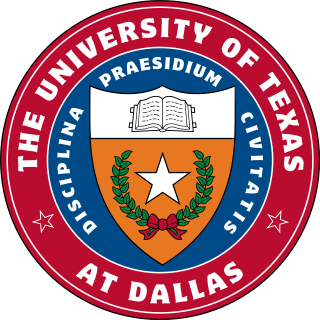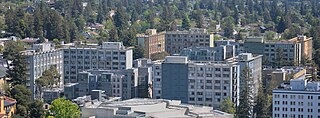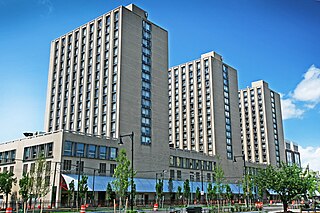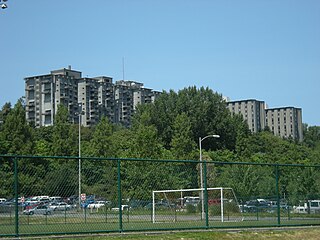
Jester Center or Jester Center Residence Halls is a co-educational residence hall at The University of Texas at Austin, built in 1969. The residence hall was named after Beauford H. Jester, who served as the Governor of Texas from 1947 until 1949.

Jester Center or Jester Center Residence Halls is a co-educational residence hall at The University of Texas at Austin, built in 1969. The residence hall was named after Beauford H. Jester, who served as the Governor of Texas from 1947 until 1949.

With a capacity of 3,200 (3,300 with supplemental housing) students, it was the largest residence hall in North America at the time it was built. [1] The building complex, which occupies a full city block, was the largest building in Austin, Texas when built and was the largest building project in University history. [2]
The complex includes two towers: a 14-level residence (Jester West) and a 10-level residence (Jester East). During the early 2010s, Jester underwent renovations that included disposition of the previously built-in furniture. While some rooms have private or connecting baths, most students use community restroom facilities. Each tower also has study rooms, lounges, laundry rooms, and storage areas. [2] From time to time, some study lounges have been converted into "supplemental housing", where 4+ students who were not allotted a standard residence hall room are roomed together.
The residence hall also houses several offices for student services, tutoring, mentoring, academic advising, classrooms, and lecture halls. The center also contains an all-you-can-eat cafeteria called "J2 Dining" (signifying Jester 2nd floor), a Wendy's (colloquially referred to as "Jendy's" [3] [4] ), an a la carte dining center known as "Jester City Limits" (an allusion to Austin City Limits ), a convenience store named "Jester City Market", Jesta' Pizza, Jester Java, which serves Starbucks, a bubble tea shop named "Bliss," and the Jesta' Texas Gift Shop, selling UT apparel. [5]
Baby grand pianos are located on the second floor of Jester West and on the first floor of Jester East, off the lobby, for the enjoyment of the residents.
The Fireplace Lounge in Jester West and the First Floor Lobby in Jester East feature large-screen televisions and comfortable chairs.
Residents often use the numerous lounge areas as meeting places or group study areas. At least one lounge is located on each floor, but there is also a 24-hour quiet study lounge across from the Jester West Desk.
Jester is located right across the street from the Perry–Castañeda Library, Gregory Gymnasium, Lee and Joe Jamail Texas Swimming Center, and many academic buildings.
Jester has a variety of room types. It is roughly half double rooms with community bath and half double rooms with connecting bath. There are two double rooms with a private bath on each floor. Jester also has several triple rooms and single rooms throughout the hall. Finally, Jester houses a significant number of students in supplemental housing spaces at the beginning of each semester. These rooms are study lounges made to house four students and are generally so popular that it's hard to get students to move out of them when permanent spaces become available.
Jester Center also houses the Learning Center, the Center for African and African-American Studies, an Engineering, Communications and Natural Sciences advising office, the Career Exploration Center and many classrooms. It is not uncommon for students to live and attend classes within Jester.
The Jester East front desk offers students the option to check out DVDs for forty-eight hours at a time.
Jester houses one large computer lab in Jester West, where residents may write papers, finish homework or complete projects.
According to student folklore, the structure was designed by an architect who specialized in prison design, specifically women's prisons due to the shower heads being placed fairly low (folklore c. at least 1983). It is true that Jester once had its own ZIP code, 78787; this was changed c. 1986. Currently, the University as a whole makes up a large part of the 78705 ZIP code, and Jester residence hall serves as a polling place for Precinct 148 in Texas Congressional District 21. [1] [6]
Jester Center was occasionally featured—particularly in panning the dorm's dining facilities—in artist Berkeley Breathed's comic strip The Academia Waltz , which was published in The Daily Texan in 1978-79, when Breathed was a UT undergrad. The strip was the predecessor to Breathed's famous Bloom County comic.

The University of Texas at Dallas is a public research university in Richardson, Texas, United States. It is the northernmost institution of the University of Texas System. It was initially founded in 1961 as a private research arm of Texas Instruments.

Texas Lutheran University (TLU) is a private Evangelical Lutheran university in Seguin, Texas.

Wesleyan College is a private, liberal arts women's college in Macon, Georgia, United States. Founded in 1836, Wesleyan was the first college in the world chartered to grant degrees to women. It opened in 1839, two years after the opening of Mount Holyoke College.

Warren Towers is one of the three Boston University dormitories traditionally intended for underclassmen, the others being The Towers and West Campus. The building is located at central campus, next to the College of Communication (COM) and across from the College of Arts and Sciences (CAS). Housing approximately 1800 students, it is the second-largest non-military dormitory in the country, behind Jester Center at The University of Texas at Austin. The closest MBTA stop is Boston University East on the Green Line B branch, located directly in front of B and C Towers, in a center reservation on Commonwealth Avenue.

With 12,500 residents, New York University has the 7th largest university housing system in the United States, the largest among private schools.

Housing at the University of California, Berkeley, includes student housing facilities run by the office of Residential and Student Service Programs (RSSP). Housing is also offered by off-campus entities such as fraternities and sororities and the Berkeley Student Cooperative (BSC).

The Boston University housing system is the 2nd-largest of any private university in the United States, with 76% of the undergraduate population living on campus. On-campus housing at BU is an unusually diverse melange, ranging from individual 19th-century brownstone town houses and apartment buildings acquired by the school to large-scale high-rises built in the 60s and 2000s.

The campus housing system at the University of Michigan in Ann Arbor, referred to as University Housing, provides living accommodations for approximately 10,000 undergraduate and graduate students. There is no requirement for first-year students to live in University Housing, yet approximately 97% of incoming students choose to do so. Every year, over 9,500 undergraduate students are housed in 18 residence halls on Central Campus, the Hill Neighborhood, and North Campus. Undergraduates, graduate students, and students with families can live in University Housing apartments in the Northwood Community on North Campus. Seven full-service dining halls as well as several retail shops provide students with daily dining options.

North Campus is a mostly residential section of Cornell University's main campus in Ithaca, New York. It includes the neighborhoods located north of Fall Creek. All freshmen are housed on North Campus as part of Cornell's common first-year experience and residential initiatives.

At the Massachusetts Institute of Technology (MIT), students are housed in eleven undergraduate dorms and nine graduate dorms. All undergraduate students are required to live in an MIT residence during their first year of study. Undergraduate dorms are usually divided into suites or floors, and usually have Graduate Resident Assistants (GRA), graduate students living among the undergraduates who help support student morale and social activities. Many MIT undergraduate dorms are known for their distinctive student cultures and traditions.

Litchfield Towers, commonly referred to on campus as "Towers", is a complex of residence halls at the University of Pittsburgh's main campus in the Oakland neighborhood of Pittsburgh, Pennsylvania, United States. Litchfield Towers is both the largest and tallest residence hall at the University of Pittsburgh, housing approximately 1,850 students.

Student housing owned by the University of California, Los Angeles is governed by two separate departments: the Office of Residential Life, and Housing and Hospitality Services, and provides housing for both undergraduates and graduate students, on and off-campus.

The upper campus residence halls at the University of Pittsburgh include Sutherland Hall, Panther Hall, K. Leroy Irvis Hall, the fraternity housing complex, and the Darragh Street Apartments. Among the newest residence facilities at the university, these buildings reside on the upper campus located near many of the school's athletic facilities. The upper campus resides approximately 200 feet (61 m) above the lower campus that lies along Forbes and Fifth Avenues, providing dramatic views along the hilltop and slopes. Planning for upper campus student housing originated in the late 1960s and early 1970s, but stalled due to community and political opposition until the early 1990s with the opening of Sutherland Hall, the first major student residence constructed by Pitt in 29 years.

Lothrop Hall is a major student dormitory at the University of Pittsburgh's main campus in the Oakland neighborhood of Pittsburgh, Pennsylvania. Lothrop Hall is located adjacent to the University of Pittsburgh Medical Center (UPMC) on Lothrop Street near Fifth Avenue, this hill is often referred to as "cardiac hill" due to its steep grade and its accessibility to medical care. The Hall is made up of 14 floors, some of which are segregated by sex in each wing. Most rooms in the hall are single occupancy, with some double occupancy as well, and even some tripled on floors 2–10. The dorm houses 723 people, in addition to a resident director and 15 resident assistants.

The residence hall system at the University of Central Florida in Orlando, Florida is administered by the Department of Housing and Residence Life. As of 2011, the system offers just under 6,500 beds on its main campus within five housing communities, 400 beds at the Rosen College of Hospitality Management, and 3,750 beds in university-affiliated housing.

Housing at Georgetown University consists of 14 residence halls at the main campus and a law center campus. Housing on Georgetown's main campus is divided between "halls," usually more traditional dormitories, and "villages", usually less traditional apartment complexes. In addition, Georgetown operates many townhouses in the Georgetown neighborhood, usually for second, third, and fourth-year students.

The main campus of the Georgia Institute of Technology occupies part of Midtown Atlanta, primarily bordered by 10th Street to the north, North Avenue to the south, and, with the exception of Tech Square, the Downtown Connector to the East, placing it well in sight of the Atlanta skyline. In 1996, the campus was the site of the athletes' village and a venue for a number of athletic events for the 1996 Summer Olympics. The construction of the Olympic Village, along with subsequent gentrification of the surrounding areas, significantly changed the campus.

Housing at the University of Washington is administered by the Housing & Food Services (HFS) department at the University of Washington. Undergraduates are housed primarily in residence halls located on North Campus and West Campus. Typically, residence halls are 9-month spaces for undergraduate students. However, there are also 12-month apartment spaces available for undergraduate students. Graduate and professional students are provided the option to live in 12-month apartments operated either by the university or privately. The University of Washington does not require students to live on campus. Although students are not required, about 71% of freshmen choose to live on campus. Housing is not guaranteed but placement in the residence halls is guaranteed for returning residents. Most winter quarter and spring quarter applicants are assigned housing. There are also three family housing options for registered full-time students at the Seattle campus.
This article needs additional citations for verification .(October 2007) |